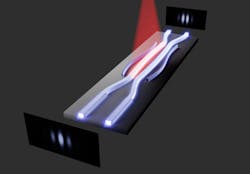Topology can play a crucial role in the generation of laser light
A collaboration between Austrian and U.S. research teams led to the development of a special laser that emits light beams with characteristic topological properties.
Topology is a mathematical discipline that involves categorizations of surfaces and bodies. In 2016, the Nobel Prize in Physics was awarded for the application of topological concepts to solid-state physics. It turns out, topology can also play a crucial role in the generation of laser light.
Scientists are interested in topological properties because they’re relatively stable against perturbations. The geometric shape of an object matters in physics, as well as its internal properties.
Alexander Schumer, a PhD student working with Professor Stefan Rotter of the Institute of Theoretical Physics at TU Wien, is exploring the topological properties of light waves with the help of computer simulations. Schumer’s doctoral thesis applies this knowledge to laser physics.
Exceptional points, singularities located at the center of a nontrivial topological structure, are the subject of intensive research within this realm. “We try to explore the topology of this structure by cycling around the exceptional point,” says Schumer. “This turns out to be difficult, however, because during such a cycle, spurious nontopological ‘jumps’ tend to ruin the topological picture.”
But they figured out how to avoid these jumps by embedding the concept of cycling an exceptional point into a laser cavity. And they created a laser mode with emission patterns at either side of the laser topologically linked through the process of cycling the exceptional point inside the laser cavity.
The team’s laser—built by Professor Mercedeh Khajvikhan’s group at the University of Southern California, and the groups of Professor Patrick LiKamWa and Professor Demetrios Christodoulides at the University of Central Florida—consists of two closely spaced main waveguides (see figure), each accompanied by a neighboring narrow strip to introduce a slight detuning.
Light can propagate along these waveguides and is partially reflected at their ends. The spacing between the two main waveguides determines the coupling strength.
“To steer the light within this system around the exceptional point, the detuning and coupling strengths are varied cyclically along the propagation direction of the light field,” says Rotter. “The gain to drive the laser is provided to one of the waveguides by a pump beam from above.”
What was the biggest challenge? “The position of the exceptional point in nonlinear systems remains at a fixed position during propagation, while the nonlinearity present in a laser moves the exceptional point around,” says Schumer. “This positional shift of the exceptional point had to be considered in such a way that the topological mode is dominant for a broad range of gain values.”
The most amazing aspect of this work is making concepts from topology accessible for laser physics, Rotter and Schumer say, without resorting to photonic lattices as done for the first realizations of topological lasers.
As far as potential applications, their work may help build robust lasers in which light is amplified over a long path.
“It will be interesting to extend our concept to exceptional points of higher order, to different types of laser modes, and to other pump mechanisms,” says Rotter. “Eventually, it will be important to demonstrate the advantage of topological robustness in real-world applications.”
About the Author
Sally Cole Johnson
Editor in Chief
Sally Cole Johnson, Laser Focus World’s editor in chief, is a science and technology journalist who specializes in physics and semiconductors.

